Important or Recent Updates
| Historic Updates | Date |
|---|---|
| New DSM7.2 Container Manager Update (Beta/RC) | 30/04/2023 |
| Fixed a typo in the ports section for 7359 | 04/07/2023 |
| Guide rewritten moving to a Project rather than the slower method via the UI giving you more flexibility. Also includes updates to improve security which is only possible via projects. | 25/10/2023 |
In this guide I am going to take you through the setup of Jellyfin in Container Manager. Please note this guide is for anyone that does not have Hardware Transcode abilities on their NAS. You can see the other guide for those that do.
Let’s Begin
As usual, it’s important you complete the three preceding guides which will get your folder structure, docker user and bridge network setup.
- Docker, Memory Recommendations and Limitations
- Step 1: Directory Setup Guide
- Step 2: Setting up a restricted Docker user
- Step 3: Setting up a Docker Bridge Network
Folder Setup
Let’s start by getting some folders set up for the container to use. Open up File Station create the following.
/docker/projects/jellyfin-compose
/docker/jellyfin
Container Manager
Next we are going to set up a ‘Project’ in Container Manager. Open up Container Manager and click on Project then on the right-hand side click ‘Create’.

In the next screen we will set up our General Settings, enter the following:
| Section | Setting |
|---|---|
| Project Name: | jellyfin |
| Path: | /docker/projects/jellyfin-compose |
| Source: | Create docker-compose.yml |
Next we are going to drop in our docker compose configuration copy all the code in the box below and paste it into line ‘1’ just like the screenshot.
What on earth is a Docker Compose? Docker Compose allows us to define how Docker should set up one or more containers within a single configuration file. This file is yaml formatted and Container Manager uses the Projects feature to manage them.

services:
jellyfin:
image: linuxserver/jellyfin:latest
container_name: jellyfin
environment:
- PUID=1234 #CHANGE_TO_YOUR_UID
- PGID=65432 #CHANGE_TO_YOUR_GID
- TZ=Europe/London #CHANGE_TO_YOUR_TZ
- JELLYFIN_PublishedServerUrl=SEE_TABLE_BELOW
- UMASK=022
volumes:
- /volume1/docker/jellyfin:/config
- /volume1/data/media:/data/media
ports:
- 8096:8096/tcp #web port
- 8920:8920/tcp #optional
- 7359:7359/udp #optional
network_mode: synobridge
security_opt:
- no-new-privileges:true
restart: alwaysThe two optional ports in the above can be removed if you will not use them. 7359 is for automated discovery of Jellyfin by the apps, and 8920 is the HTTPS port which is useful if not using the reverse proxy later in the guide.
Environment Variables
We need to make some changes in order for the container to have the correct permissions to save its configuration files and to have access to your media.
| Variable | Value |
|---|---|
| PUID | (required) The UID you obtained in the user setup guide |
| PGID | (required) The GID you obtained in the user setup guide |
| TZ | (required) Your timezone wikipedia.org/wiki/List_of_tz_database_time_zones |
| JELLYFIN_PublishedServerUrl | This will be your NAS IP or if you are going to be accessing via your DDNS address use this. (You can change this later if you wish) |
Volumes
We can now pass through our file paths into the container they are mounted using the volume’s section of the compose file.
I have pre-filled this section to pass the correct paths, the only thing that you may need to change is the /volume1/ if your file paths are on a different volume.
Click ‘Next’
You do not need to enable anything on the ‘Web portal settings’ screen click ‘Next’ again.

On the final screen click ‘Done’ which will begin the download of the container images and once downloaded they will be launched!

The image will now be downloaded and extracted. You should see ‘Code 0’ when it has finished.

You will now see your Jellyfin running and should have a green status on the left-hand side.
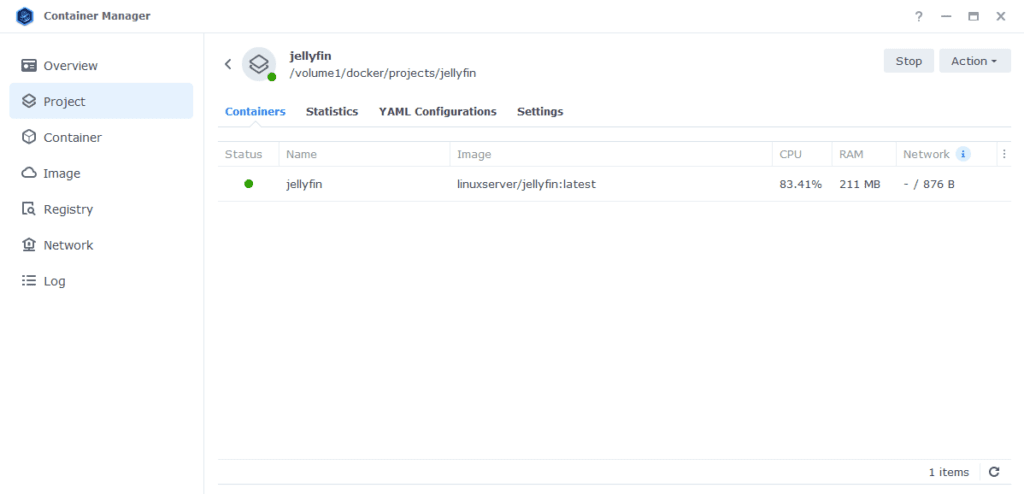
Firewall Exceptions
(Skip if you don’t have the Firewall configured)
If you have enabled and configured the Synology Firewall you will need to create exceptions for any containers that have a Web UI or have any incoming or outgoing connections. This section covers the basics of how to add these. (Please note this is a generic section and will not show the specific ports used in this guide however it applies in the same way)
Also, I would like to refer people to the great guide on getting the Firewall correctly configured over on WunderTechs site.

Head into the Control Panel> Security > Firewall, from here click Edit Rules for the profile you set up when you enabled the Firewall.

Next click on Create and you will see the screen below. Source IP and Action will be automatically selected to All and Allow, I will leave it up to you as to your own preference on whether you want to lock down specific Source IPs from having access. In this example we will leave as All.
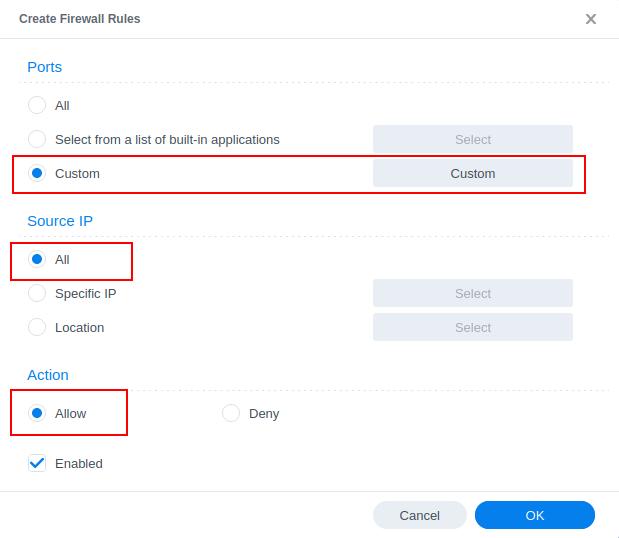
You will now choose ‘Custom‘ and then the Custom button
Now select Destination from the drop-down menu, most web based containers require TCP access but check the guide as it will show the port and protocol. Then add comma separated ports. Then press OK.
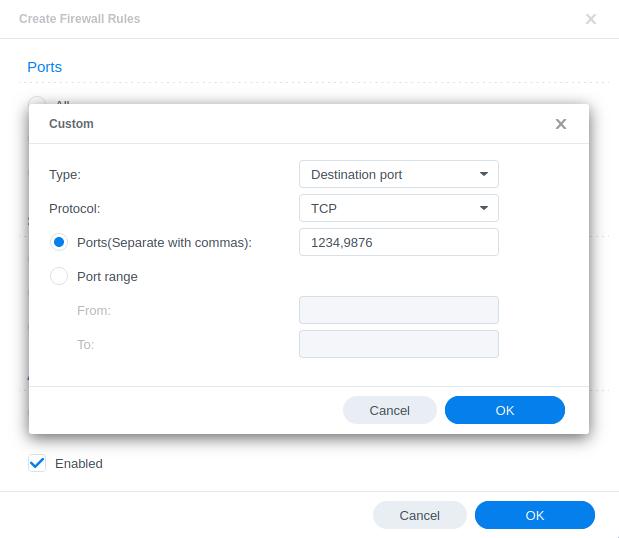
Click OK a couple of times to get back to the main screen. You will see by default the new rule is added to the bottom of the list. You must always have your Block All rule last in the list as the rules are applied top down so move your container up.
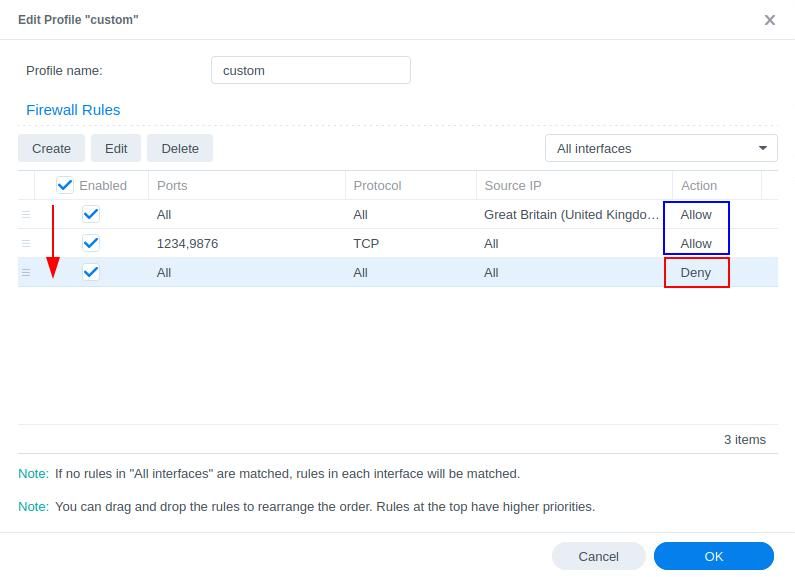
You have now completed the Firewall changes and can continue with the guide.
Jellyfin Initial Setup
After a few minutes you should be able to access the server and go through the initial Jellyfin setup by going to the IP of your NAS in your browser followed by port 8096.
e.g. 192.168.0.30:8096
When adding movies or shows they will be located in the /data/media folder.
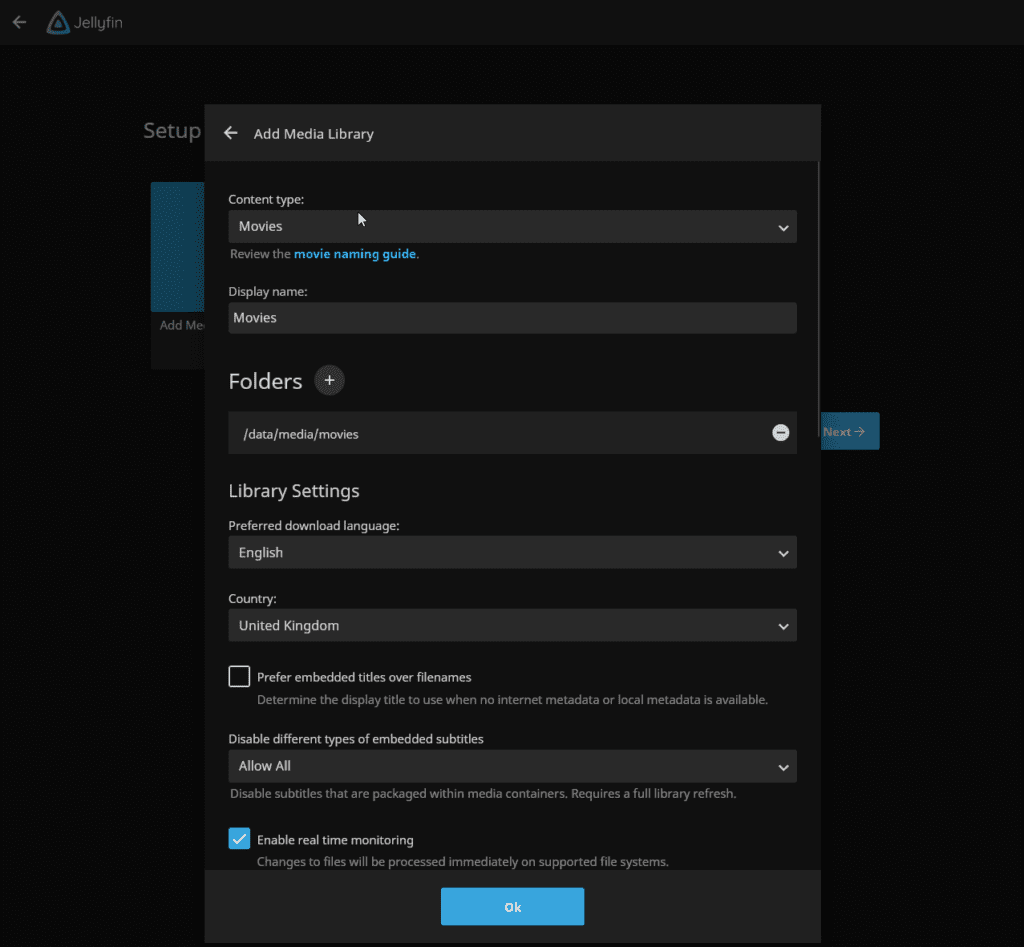
Remote Access
If you are going to be using your set-up outside your LAN you will also need to enable the following options to allow access and also to restrict bandwidth
Allow remote connections to this server

Streaming
In order to limit upload bandwidth you can also set an overall limit for streams, this is useful if you or other users will be trying to play back files larger than your upload bandwidth can handle

Part 2 – DDNS, SSL and Reverse Proxy
Before we start, make sure you have registered for a Synology Account as we are going to be using their DDNS service. https://account.synology.com/en-uk/register/
In order to successfully use the reverse proxy you will also need to forward port 443 to you NAS IP. (You will need to check how to do this on your own router) This port is used for secure web traffic.
DDNS (Dynamic Domain Name System)
A DDNS address allows you to get external access to Jellyfin via a subdomain provided by Synology, this is useful on home internet connections where your ISP will change your IP address on a regular basis. (If you already have this set up via another guide you can skip to the Reverse Proxy section)
Note: If you want to access DSM via this new address you will either need to create an additional Reverse Proxy for it or open port 5001 on your router.
In the DSM Control panel go to ‘External Access’ and then to the ‘DDNS’ tab

Click on ‘Add’, then fill out the following sections.
| Section | Value |
|---|---|
| Service Provider | Synology |
| Hostname | This can be anything it will be used to access your NAS externally |
| Email: | Log into your Synology account |
| External Address (IPv4) | This should be filled in automatically |
| External Address (IPv6) | This should be filled in automatically if your ISP is using IPv6 |
| Get a Cert from Let’s Encrypt | Tick this box |
| Enable Heartbeat | Tick this box |
Now press OK, DSM will apply your settings. It can take a few moments to set up and the DSM interface will refresh. You will likely receive a certificate error which you will need to accept to get back into DSM.
You should now test that you can access your Diskstation via the hostname you requested and not receive any SSL errors.
Reverse Proxy
So you don’t have to open up additional ports on your router for Jellyfin we are going to set up a reverse proxy subdomain. This means you and your users can access Jellyfin without using a port number as it will route all traffic through the secure 443 port.
Go back into the Control Panel and access the ‘Login Portal’ then in the ‘Advanced’ tab click ‘Reverse Proxy’ and then click on ‘Create’.

We are now going to enter some rules, so when you or your users access the URL specified the request will automatically be sent to the Jellyfin web UI.
Use the settings below, you will need to amend the Hostname sections in line with the hostname you registered earlier, and the IP of your NAS.
| Setting | Value |
|---|---|
| Reverse Proxy Name: | jellyfin |
| Protocol: | HTTPS |
| Hostname: | jellyfin.xxx.synology.me (change the part after ‘jellyfin.’ to your own hostname you registered earlier. |
| Port: | 443 |
| Protocol: | HTTP |
| Hostname: | Your NAS IP or ‘localhost’ |
| Port: | 8096 |

On the second tab ‘Custom Header’ click on Create then WebSocket, this will add two entries which will force a https connection if you ever try to connect over http, you can now press save.
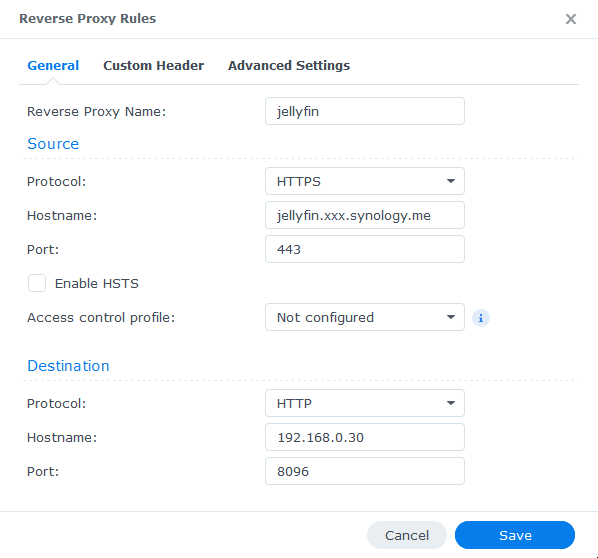
You should now be able to access the Jellyfin login screen to https://jellyfin.yourhostname it will be a secure connection, and you should have no SSL errors.
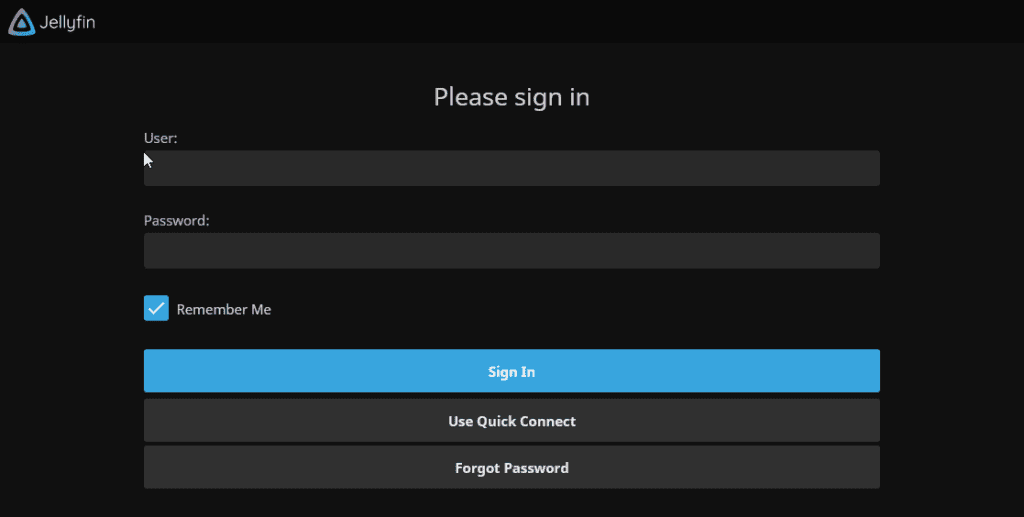
You can now log in with the username and password you created earlier, the same address is used in the Android and iPhone apps.
Looking for some help, join our Discord community
If you are struggling with any steps in the guides or looking to branch out into other containers join our Discord community!
Buy me a beverage!
If you have found my site useful please consider pinging me a tip as it helps cover the cost of running things or just lets me stay hydrated. Plus 10% goes to the devs of the apps I do guides for every year.




How do I update jellyfin?
Hey – See the left menu for a couple of ways to update your containers 🙂
Hi Dr. Frankenstein!
I did everything as you recommend and the Jellyfin is running but I am having this weird error that doesn’t make sense to me (because the folder does not even exist). This is happening in a loop.
—> System.IO.IOException: Permission denied
System.UnauthorizedAccessException: Access to the path ‘/config/data/data’ is denied.
Unhandled Exception
failed to load external entity “/config/network.xml”
That path references the files in /volume1/docker/jellyfin/data/data is there anything inside that folder as there should be files.. I would try running the permission fix from the User and Group guide but adjust the path it has on it to just the one I just mentioned
Thanks a lot for the reply!
The file does not exist at all. Should it?
I have installed the docker several times now and it never gets created and no issue during the setup of the Jellyfin project.
OK can you jump back to the User and Group guide and run the permission fix (should be the first one as per the dates) then re-run the setup and the files should be created
Unfortunately when I try to enter Jellyfin using the secured connection, it freezes. Any idea how to resolve that?
Hey I spotted you email – I will reply soon, just bare with me as its a holiday weekend here in the UK.